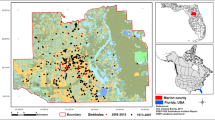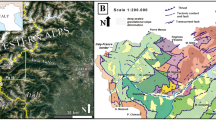Abstract
Sinkhole collapse in the area of Maryland Interstate 70 (I-70) and nearby roadways south of Frederick, Maryland, has been posing a threat to the safety of the highway operation as well as other structures. The occurrence of sinkholes is associated with intensive land development. However, the geological conditions that have been developing over the past 200 million years in the Frederick Valley control the locations of the sinkholes. Within an area of approximately 8 km2, 138 sinkholes are recorded and their spatial distribution is irregular, but clustered. The clustering indicates the existence of an interaction between the sinkholes. The point pattern of sinkholes is considered to be a sample of a Gibbsian point process from which the hard-core Strauss Model is developed. The radius of influence is calculated for the recorded sinkholes which are most likely to occur within 30 m of an existing sinkhole. The stochastic analysis of the existing sinkholes is biased toward the areas with intensive land use. This bias is adjusted by considering (1) topography, (2) proximity to topographic depressions, (3) interpreted rock formation, (4) soil type, (5) geophysical anomalies, (6) proximity to geologic structures, and (7) thickness of overburden. Based on the properties of each factor, a scoring system is developed and the average relative risk score for individual 30-m segments of the study area is calculated. The areas designated by higher risk levels would have greater risk of a sinkhole collapse than the areas designated by lower risk levels. This risk assessment approach can be updated as more information becomes available.







Similar content being viewed by others
References
Beck BF (1991) On calculating the risk of sinkhole collapse. In: Kastning EH, Kastning KM (eds) Appalachian Karst, Proceedings, Radford, Virginia, National Speleological Society, Huntsville, Alabama, pp 231–36
Boyer BW (1997) Sinkholes, soils, fractures, and drainage: Interstate 70 near Frederick, Maryland. Environ Engineer Geosci 3(4):469–485
Brezinski DK, Reger JP (2002) Stratigraphy–karst relationships in the Frederick Valley of Maryland. US Geological Survey Karst Interest Group Proceedings, Shepherdstown, West Virginia, 20–22 August 2002, Water Resources Investigation Report 02-4174, pp 59–65
Dreybrodt W (1988) Processes in karst system: physics, chemistry, and geology, Springer, Berlin Heidelberg New York, 288 pp
Guigon MT, Dine JR (1987) Water resources of Frederick County, Maryland. Maryland Geological Survey, Bulletin 33
Hanisch KH, Stoyan D (1983) Remarks on a statistical inference and prediction for a hard-core clustering model. Methods Stat 14:559–567
Jonas GW, Stose AI (1938) Geologic map of Frederick County. Maryland Geological Survey, Baltimore, Maryland
LaMoreaux P.E. and Associates, Inc. (1996) Evaluation of the risk of sinkhole collapse at the City Sewage Treatment Lagoon, Sullivan, Missouri. Consulting report prepared for the city of Sullivan, Missouri
Meyer G, Beall RM (1958) The water resources of Carroll and Frederick Counties. State of Maryland, Board of Natural Resources, Dept of Geology, Mines and Water Resources, Baltimore, Maryland, Bulletin 22
Moore JD, Hinkle F, Moravec GF (1977) High-yield wells and springs along lineaments interpreted from LANDSAT imagery in Madison County, Alabama, USA. In: Tolson, Doyle (eds) Karst hydrogeology. UAH Press, Huntsville, pp 477–486
Newton JG (1987) Development of sinkholes resulting from man's activities in the eastern United States. US Geological Survey, Circular 968, 54 pp
Nutter LJ (1973) Hydrogeology of the carbonate rocks, Frederick and Hagerstown Valleys, Maryland. Maryland Geological Survey, Baltimore, Maryland, Report of Investigation No 19
Reinhardt J (1974) Stratigraphy, sedimentology and cambro-Ordovician paleogeography of the Frederick Valley, Maryland. Maryland Geological Survey, Baltimore, Maryland, Report of Investigation No 23
Reuter F, Stoyan D (1993) Sinkholes in carbonate, sulphate, and chloride karst regions: principles and problems of engineering geological investigations and predictions, with comments for the construction and mining industries. In: Beck BF(ed) Applied karst geology. A.A. Balkema, Rotterdam, pp 3–25
Rummel, Klepper, Kahl (1996) Report of geotechnical engineering investigation of Marc Service Station, Frederick Junction to Downtown Frederick Station 38+75 to Station 207+72, Frederick County, Maryland. Prepared for Maryland Department of Transportation, Baltimore, Maryland
RUST (1997) Interim technical report for phase II karst evaluation. Prepared for Earth Engineering & Sciences, Inc., Baltimore
Soil Conservation Service (1960) Soil survey Frederick County Maryland. Soil Conservation Services, Washington, DC
Sowers G F (1996) Building on sinkholes. ASCE Press, New York, 202 pp
Stoyan D (1987) Applications of stochastic geometry. Bernoulli Conf Proc, VNU Science Press, pp 563–572
Stoyan D, Kendall WS, Mecke J (1987) Stochastic geometry and its applications. Chichester, G.B., Wiley, New York, 345 pp
Technos Inc. (1997) Assessment of karst conditions along I-70 near the town of Frederick, Maryland. Prepared for Maryland State Highway Administration, Baltimore, Maryland
Upchurch SB, Littlefield Jr. (1987) Evaluation of data for sinkhole-development risk models. In: Beck BF, Wilson WL (eds) Proceedings of 2nd Multidisciplinary Conference on Sinkholes and the Environmental Impacts of Karst, Orlando, 9–11 February 1987. A.A. Balkema, Rotterdam, pp 359–364
Zhou WF (1997) The formation of sinkholes in karst mining areas in China and some methods of prevention. Environ Geol 31(1/2):50–58
Author information
Authors and Affiliations
Corresponding author
Rights and permissions
About this article
Cite this article
Zhou, W., Beck, B.F. & Adams, A.L. Application of matrix analysis in delineating sinkhole risk areas along highway (I-70 near Frederick, Maryland). Env Geol 44, 834–842 (2003). https://doi.org/10.1007/s00254-003-0828-8
Received:
Accepted:
Published:
Issue Date:
DOI: https://doi.org/10.1007/s00254-003-0828-8




